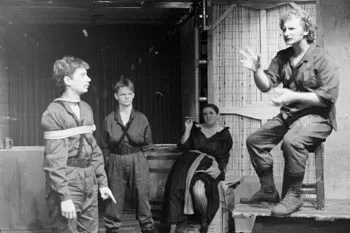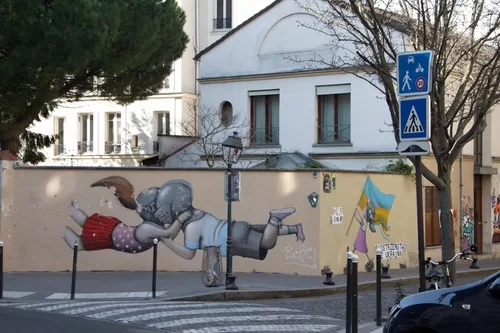In all my years in event photography, one production stands out as an absolute joy to watch. The actors, some of whom were deaf, were fully committed to the role and the art of story telling, incredibly expressive and both the actors and audience were thoroughly enjoying themselves.
The funny thing is the play … Brecht’s Man Equals Man is not a comedy … but by intentionally turning the play into a comedy, the impact was all the more profound.
The Theatre of the Deaf staged Brecht’s “Man Equals Man” in 1985 at the Sydney Theatre Company’s Studio Theatre located at the Wharf.
Brecht’s play: Man Equals Man
The theatre play “Man Equals Man” was written by the renowned German playwright Bertolt Brecht. It was first performed in 1926 and is one of Brecht’s early works. The original German title of the play is “Mann ist Mann.” which translates as “Man Equals Man” or “A Man’s a Man”.
The story is set in British-occupied India and centers around a character named Galy Gay, a simple and unremarkable porter. Galy Gay is manipulated and transformed into a soldier by a group of soldiers who want to make him one of their own.
The soldiers change his appearance and identity, turning him into a new man, and this transformation serves as an allegory for the malleability of human identity and the dehumanizing effects of war and social conditioning.
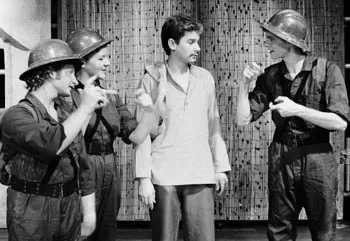

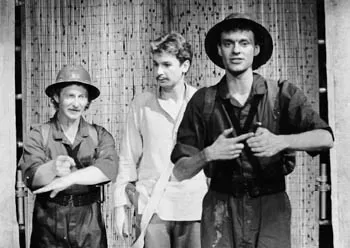

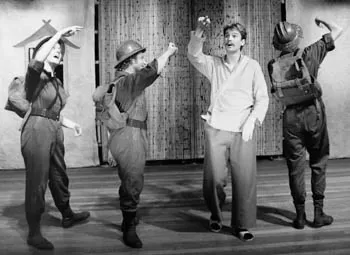

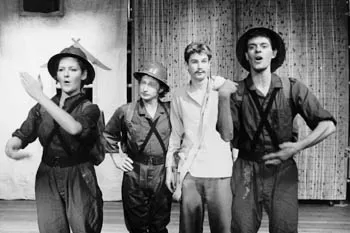

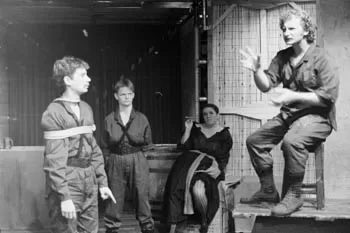

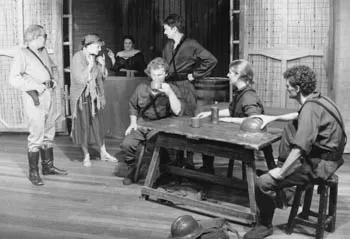

“Man Equals Man” is a prime example of Brecht’s “epic theater” style, which seeks to engage the audience intellectually and emotionally by presenting characters and situations that challenge conventional notions of identity and social conformity.
The play features songs and music, as well as a Brechtian approach to acting, where actors do not fully immerse themselves in their characters but maintain a critical and reflective distance from the roles they play.
The play explores themes of identity, conformity, the dehumanizing effects of war, and the manipulative power of authority figures. It’s a thought-provoking and challenging work that invites the audience to question societal norms and the fluid nature of human identity.
Theatre of the Deaf, 1985
The Theatre of the Deaf’s production was directed by Ben Strout with set design by Ilonka Craig and
costume design by Imogene Hall. The cast was: Colin Allen, Carol-Lee Aquiline, Janet Kitcher, David London, David Pidd, Steve Ripley, Martha Rundell, Catherine Gillard.
This highly entertaining rendition of Brecht’s play by The Theatre of the Deaf provided a unique and engaging experience for the audience. Combining music with the dynamic artistry of simultaneous sign language and spoken word, the production was an innovative and humorous theatrical performance.
The production ran from 10 to 27 April, 1985, marking the company’s first public season since their performance of “A Winter’s Tale” in 1981.
Carol-Lee Aquiline and Colin Allen
Carol-Lee Aquiline worked at the National Theatre of the Deaf (USA) from 1978 to 1982 before coming to Australia to teach Deaf Theatre, initially for one year, but staying for over ten years. Carol-lee became the first Deaf Artistic Director of the Australian Theatre of the Deaf, the first Manager of the Australian Association of the Deaf (AAD) National Advocacy Service and then Executive Director of AAD. She relocated to Europe in 1996 to take up the role of General Secretary for the World Federation of the Deaf (WFD), collaborating with the United Nations, UNESCO, and WHO. Carol-lee returned to the USA in 2005.
Colin Allen was a professional actor with the Australian Theatre of the Deaf from 1976 to 1982. In 2011, he was elected as the President for the World Federation of the Deaf (WFD) and has distinguished himself advocating for deaf people on the world stage.














Carol-Lee Aquiline and Colin Allen stole the show when Theatre of the Deaf performed Brecht’s Man Equals Man in Sydney. © Mark Anning photos, All Rights Reserved. Contact us.
The Theatre of the Deaf, serving as Australia’s leading professional deaf theatre company, was a unique and inclusive ensemble. Comprising both deaf and hearing actors, they employed a captivating blend of sign language, vocalisation, mime, and gesture to craft a distinctive style of theatre.
Established in 1979 under the patronage of the Australian Elizabethan Theatre Trust, The Theatre of the Deaf received crucial financial support from the Theatre Board of the Australian Council and the office of the Minister for the Arts in New South Wales.
The company primarily functioned as a theatre-in-education team, annually captivating around 50,000 students in schools across New South Wales, with tours extending to Tasmania, Victoria, the ACT, and South Australia.






In 1995, Theatre of the Deaf officially transitioned into the Australian Theatre of the Deaf and continued in this capacity for the next 15 years. During this time, the company conducted nationwide tours of their productions and conducted educational theatre workshops.
Starting in 2011, they initiated a collaboration with Arts Access Victoria. However, in 2018, the Australian Theatre of the Deaf concluded its formal operations, though they remain engaged on social media platforms, actively promoting opportunities for deaf actors and the theatrical arts. Australian Theatre of the Deaf is on facebook.
The Australian Elizabethan Theatre Trust was founded in 1954. The roots of the Australian Theatre of the Deaf trace back to the early 1970s, spearheaded by Nola Colefax (who became a Patron of the Company) and a group of Deaf individuals.
Their aim was to entertain and engage the deaf community, providing a platform for creative expression among deaf people. Their primary focus was on crafting a theatre specifically tailored to the deaf community—a theatre “FOR the Deaf.”
In 1979, with crucial support from the Australia Council’s Theatre Board and the Elizabethan Theatre Trust, the Theatre of the Deaf made its official debut as a professional theatre company. With this transition, their emphasis shifted to becoming a theatre “OF the Deaf,” now catering to both hearing and deaf audiences.
During the initial decade, the company primarily concentrated on staging European classics, including works by Shakespeare, Beckett, Brecht, and even Tennessee Williams. These productions were presented in sign language, often accompanied by voice-over interpreting from the wings or enacted by hearing actors on stage.
In 1982, Wendy Blacklock inaugurated the Australian Content Department within the Australian Elizabethan Theatre Trust, which eventually embarked on a tour of seven productions in 1990. This department later underwent a name change to “Performing Lines.”
Judi Farr, who as Madge the manicurist, uttered one of the most famous lines on Australian television – “you’re soaking in it” – ran the Australian Content by the mid-1980s. The Musical Department, led by Noel Ferrier, brought forth notable productions, including “The Sound of Music.”
A 29 year old American Ben Strout was appointed artistic director of the N.SW. Theatre of the Deaf in 1983. He has joined the company after spending four years with the National Theatre of the Deaf in the United States and has great ambitions for the company and the work it can present to both adults and children.
Related stories
This story is part of a feature series on Bertolt Brecht and the 1980s theatre scene by photographer & writer, Mark Anning.
Heinrich Hoffman photographs Adolf Hitler public speaking
John Bell re-enacts historic Hitler – Hoffman photo session
The history of the Nimrod Theatre Company, Sydney
Brecht, Hollywood Ten, House UnAmerican Activities Committee
Bertolt Brecht: Revolution in Theater & Social Consciousness
The history of the Nimrod Theatre Company, Sydney
National Institute of Dramatic Art (NIDA)
Kathy Lette, Gabrielle Carey and Puberty Blues
Jesus Christ Superstar Australian Cast – Theatre Photography
Performance art or exhibitionism? Artist arrested in Paris
Where is Marina Finlay now Portrait of an Artist
Kenneth Radley Is One Of Those Australian Actors …
Further reading
Man Equals Man and the Elephant Calf: And the Elephant Calf
The Resistible Rise of Arturo Ui by Bertolt Brecht, et al (Paperback – February 2001)
The Good Woman of Setzuan — by Bertolt Brecht, Eric Bentley
Collected Stories — by Bertolt Brecht, et al; Paperback
Mother Courage and Her Children — by Bertolt Brecht, Eric Bentley
Brecht Collected Plays Vol 1 — Bertolt Brecht, et al (Paperback – Methuen Publishing Ltd – 30 August, 1994)
The Resistible Rise of Arturo Ui — Bertolt Brecht, et al (Paperback – Methuen Publishing Ltd – 3 September, 1981)
Brecht Collected Plays Vol 6 — Bertolt Brecht, et al (Paperback – Methuen Publishing Ltd – 30 August, 1994)
Required disclaimer: We may earn a small commission from sales via Amazon.

